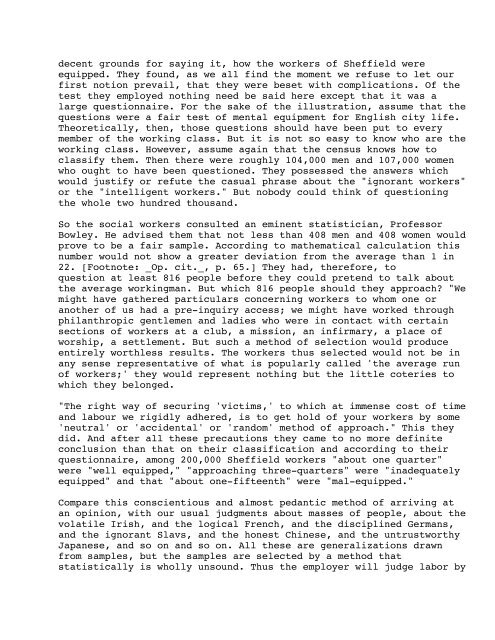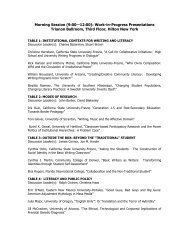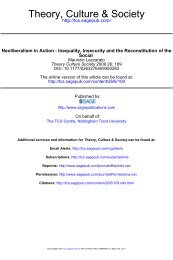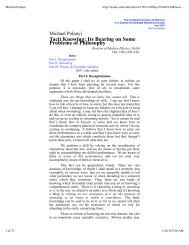PUBLIC OPINION by WALTER LIPPMANN TO FAYE LIPPMANN ...
PUBLIC OPINION by WALTER LIPPMANN TO FAYE LIPPMANN ...
PUBLIC OPINION by WALTER LIPPMANN TO FAYE LIPPMANN ...
Create successful ePaper yourself
Turn your PDF publications into a flip-book with our unique Google optimized e-Paper software.
decent grounds for saying it, how the workers of Sheffield were<br />
equipped. They found, as we all find the moment we refuse to let our<br />
first notion prevail, that they were beset with complications. Of the<br />
test they employed nothing need be said here except that it was a<br />
large questionnaire. For the sake of the illustration, assume that the<br />
questions were a fair test of mental equipment for English city life.<br />
Theoretically, then, those questions should have been put to every<br />
member of the working class. But it is not so easy to know who are the<br />
working class. However, assume again that the census knows how to<br />
classify them. Then there were roughly 104,000 men and 107,000 women<br />
who ought to have been questioned. They possessed the answers which<br />
would justify or refute the casual phrase about the "ignorant workers"<br />
or the "intelligent workers." But nobody could think of questioning<br />
the whole two hundred thousand.<br />
So the social workers consulted an eminent statistician, Professor<br />
Bowley. He advised them that not less than 408 men and 408 women would<br />
prove to be a fair sample. According to mathematical calculation this<br />
number would not show a greater deviation from the average than 1 in<br />
22. [Footnote: _Op. cit._, p. 65.] They had, therefore, to<br />
question at least 816 people before they could pretend to talk about<br />
the average workingman. But which 816 people should they approach? "We<br />
might have gathered particulars concerning workers to whom one or<br />
another of us had a pre-inquiry access; we might have worked through<br />
philanthropic gentlemen and ladies who were in contact with certain<br />
sections of workers at a club, a mission, an infirmary, a place of<br />
worship, a settlement. But such a method of selection would produce<br />
entirely worthless results. The workers thus selected would not be in<br />
any sense representative of what is popularly called 'the average run<br />
of workers;' they would represent nothing but the little coteries to<br />
which they belonged.<br />
"The right way of securing 'victims,' to which at immense cost of time<br />
and labour we rigidly adhered, is to get hold of your workers <strong>by</strong> some<br />
'neutral' or 'accidental' or 'random' method of approach." This they<br />
did. And after all these precautions they came to no more definite<br />
conclusion than that on their classification and according to their<br />
questionnaire, among 200,000 Sheffield workers "about one quarter"<br />
were "well equipped," "approaching three-quarters" were "inadequately<br />
equipped" and that "about one-fifteenth" were "mal-equipped."<br />
Compare this conscientious and almost pedantic method of arriving at<br />
an opinion, with our usual judgments about masses of people, about the<br />
volatile Irish, and the logical French, and the disciplined Germans,<br />
and the ignorant Slavs, and the honest Chinese, and the untrustworthy<br />
Japanese, and so on and so on. All these are generalizations drawn<br />
from samples, but the samples are selected <strong>by</strong> a method that<br />
statistically is wholly unsound. Thus the employer will judge labor <strong>by</strong>





